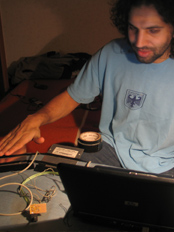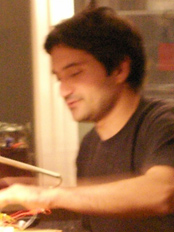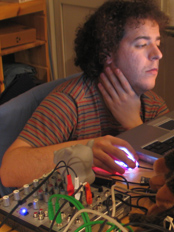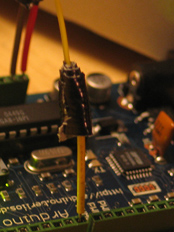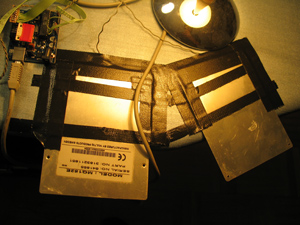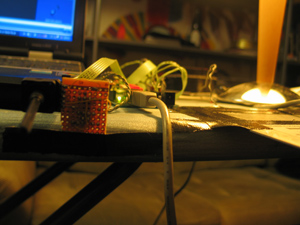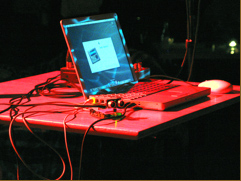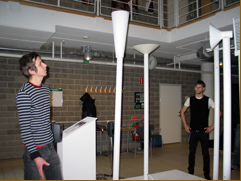|
||||||||||||
|
EMI project gives a possibility to non-professional musicians to experience a musical
activity where the pleasure is achieved by being able to play around with the reliable instrument, exploring and experimenting
on different sound structures. With the characteristics of the instruments such as easy to use, easy to control, EMI project
instruments can easily bring performers with no training or formal education in music, together to experience ever-changing
music in a collective improvisation process. In a collective musical improvisation pleasure is maximized in higher scale.
ARDUINO Arduino is a pan-European open hardware initiative aiming to provide the design and art community with a tool to create alternative electronic interfaces. Those could act as more natural bonds to computers, allowing us to interact in new, unforeseen ways. Another possibility is the creation of standalone electronic devices. The standardization of personal computers has also brought a whole range of in/output devices meant to simplify the ways we interact with the machine. The so-called peripherals have been designed to optimize certain tasks. Some artifacts, like the keyboard and the mouse, have become ubiquitous to us in the sense that we have learned to interact with them a natural way. However, the existing peripherals are too limited when it comes to perform very precise operations like the ones a musician performs on her instrument.
Taking this need as a starting point there have been several attempts during the last years for creating alternative tools
that would give musicians a certain feeling of control on the instrument. Arduino is yet another of these initiatives.
PHYSICAL INTERACTION TO DIGITAL ENTITY During the last years there has been a development of several open source software platforms that allow the creation of multimedia performative experiences. These new tools have been embraced by multitude of users, what has help further development through distributed debug processes. Like every time a new technology arises, there are groups of pioneers that dedicate time to study the advantages it may offer
to them. These are known as early adopters and face situations when the designs are unfinished. Eventually they may not be functional.
This gives them the chance to shape this technology through critique to the designers. This is precisely what is happening with Arduino
and PureData. A big part of ArduinoÕs early adopterÕs community happens to be composed by electronic musicians performing with PureData.
Both projects are characteristic for promoting open dissemination of knowledge, which has generated very strong synergies between users
and developers at the both sides.
GESTURE AND FEEDBACK In the process of developing instruments, EMI integrates Arduino and PureData to map physical interaction within a digital environment. PerformerÕs physical gesture creates the first attempt to interact with the musical instrument. Digital response to a physical gesture creates the interaction between performer and the instrument. Immediate answers make it possible
for performers to have a control on their instruments. In this sense, gesture and feedback are in continues relation. Whenever there is a
gesture, there is a feedback. This also makes it interesting for the performer to explore the instrument further more.
RELIABLE INSTRUMENTS As EMI, the authors become luthiers crafting the interaction behind new musical artifacts for performers without a traditional musical education. We share a common vision on what constitutes music, as well as, which should be the skills required to play an instrument. Looking beyond the concept of music, and performance, we wonder what makes some instruments successful and even evolve in form and sound qualities, while others disappear in the history of humanity. Culture conditions the form and tonal scale of ÒtraditionalÓ instruments. Certain instruments are associated with certain types of music, we claim that a non-traditional musical instrument can also free the performer from existing tonal structures, and even can make it possible to concentrate more on being musically creative with new musical structures that have never been heard before Arduino makes it possible to hack almost everything and turn it to be a musical instrument. Sound processing part of these instruments is
completed with PureData, real time sound processing environment. When a performer figures out the rules, then performer can begin to control
the instrument and begin the musical activity.
MAXIMAZING PLEASURE During the interaction with the musical instrument, pleasure is achived when a performer explores a changing set of sonic relationships overtime. Exploring the range of a particular instrument creates a musical activity. PerformerÕs responses in this activy are targeted to contol the instrument. Performer feels confortable with an instrument that can be controled easily. This imidiately encourages performer to explore further more the sound structures that instrument can offer. Controlling instrument leads performer to explore and experiment with the desired sound structures for that performance. Our approach, in developing reliable instruments aims to maximize the pleasure that performer can get while playing around with the musical instrument. With these reliable insruments, instead of spending time to figure out how that instrument itself works, performer can concentrate more on developing techniques on manuplating sound structures for mastering that instrument. In EMI project we share the common knowledge on the characteristics of the instruments. Our main target is non- professional musicians; therefore, we aim to develop musical instruments that can be controled easily without having a complex musical knowledge. Since the sounds are easily manuplated in digital environments, developing a tacit knowledge around these musical instruments is the major process in creating easy to play, easy to control identies for EMI project instruments. On the other hand, we do not disregard the sensory satisfaction of ear. Sound structures will keep the ear pleasure providing intensive interaction with the performer. Process of playing the instrument with a sensory satisfaction of ear will make a progress in a more informal way in mastering that instrument.
In more traditional music, musicians spend years on mastering their instruments to play all kinds of musical repartuars perfectly, as those
repartuars are expected to be played. In this context, mastering as a term can be understood slightly different than what we are interpreting
in EMI project; however, getting better in controling the instrument with a basic knowledge at a time, will maximize the pleasure that a performer
can get in a musical activity with an experimental musical instrument.
EXPERIENCES The first official EMI project meeting happened in Malm on Thursday, 8th of December 2005. During a four days workshop and meeting, we were experimenting with new interfaces and new sound structures. We hacked a video player front panel, and used its controllers as an interface. Ready-made sensors were also easy to be developed into a musical instrument. Sound structures were pleasing enough and in touch with the physical gestures that we captured with the interfaces. Our advantage was the well integration of Arduino and PureData environments. Instead of dealing with technical issues, we spend more time on creating and experimenting with the pleasure around the musical instruments. During the night of the third day, we had a performance with our new EMI project instruments. Improvisation performance was satisfactory enough to develop new ideas and new strategies for EMI project. Between October and December 2005 the School of Arts and Communication (K3) in Malm, Sweden, conducted a prototyping course which brief for the students was to create basic auditory expressions of sensor technology. We chose PureData as the platform for sound reproduction, while Arduino became the technology for capturing sensor information in the computer. The whole experience came to a moment of climax when one of the students, after less than a week work with electronics, decided to perform at the release of his of music-CD using Arduino as the input to a self-made sampler in PureData. Again at K3, during the Physical Computing course in the Fall term 2005, five students developed a piece called Urban Forest. This consisted of a
group of the so-called ÒtreesÓ, which were constructions equipped with an Arduino powered circuit board that could record up to one and a half minutes
of sound each. When placed back to the Òurban forestÓ the visitor could play the pre-recorded sound through slightly touching the deviceÕs surface,
at different points. All the trees would send their audio information to a computer with 4 sound cards, and the entire sensor data would also be sent
to it. Thus, a single computer could control the whole installation containing 5 of those "trees".
PROCESS EMI project intents to explore ideas to give possibilities for performers, with all kinds of musical backgrounds, to experience, the pleasure in performing musical activity. EMI project will continue developing non-traditional experimental musical instruments and perform with them in various music events. Our common knowledge on EMI project will definitely be enlarged with the feedback we will get from the performers of these instruments. Open source environments are in continuous development with the works of the developers in that community. EMI project is in touch with the developers of these open source environments, which makes EMI project evolve as well. Yet another important effect of using open source technologies within the field of instrument creation is the democratization of the tools. It is not only that the tools themselves are open as such, but most of the times also the creation process of the tools is up to participation. As a matter of fact, PureData and Arduino, the tools proposed in this paper, are well known for the influence users have in the design through on-line community forums, and email lists. Furthermore, and this is an obvious consequence of the use of sensors and alternative user interfaces, contemporary electronic music is in a way moving away from the laptop. The almost-rudely-called Òlaptop musiciansÓ may be considered again as luthieres, professional instrument builders. |
|||||||||||

